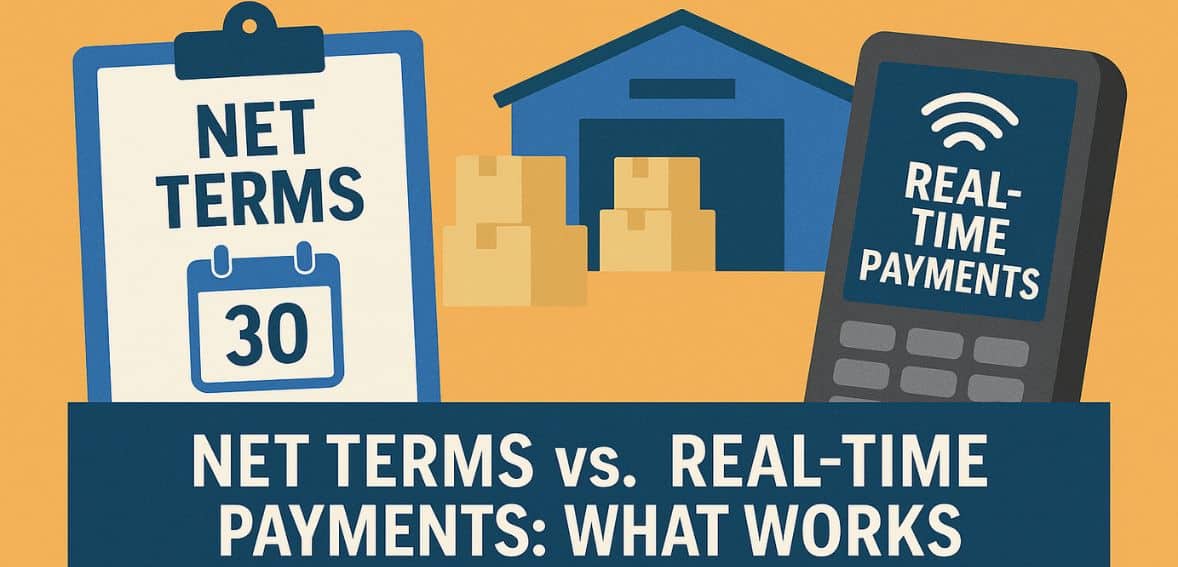
By alphacardprocess July 29, 2025
Relationships, inventory cycles, and steady cash flow are key components of successful wholesale businesses. These dynamics are based on payment practices, such as allowing real-time payments or providing net terms. Net terms, such as Net-30 or Net-60, have long been a common business offering, giving buyers flexibility and allowing sellers to increase sales volume and trust.
However, they can put a strain on liquidity and necessitate a lot of management. Instant settlement, ease of use, and enhanced cash visibility are all provided by real-time payment systems made possible by ADP networks or FedNow platforms. However, they might not accommodate every buyer’s preference or industry standard.
It’s necessary to align your cash needs, client expectations, and internal procedures with operational efficiency and strategic clarity to determine which model best suits your needs.
The Appeal and Risks of Offering Net Terms
Buyers are permitted to pay within a certain time frame following delivery or invoicing under net terms, which are most frequently Net-30, Net-60, or, infrequently, Net-90. Because it fosters strong relationships, facilitates larger orders, and offers the potential for early payment incentives, this model has historical appeal. Net terms can help sellers stand out in crowded markets and close deals with new or low-income customers.
But there are actual expenses. If you don’t have adequate liquidity or credit available, deferred receipts may cause cash flow problems. Running credit checks, pursuing past-due payments, sending reminders, and manually reconciling receivables are all part of managing net terms. In the worst-case scenarios, buyers might postpone or default completely, resulting in losses and administrative strain.
The Rise of Real‑Time Payments and What They Deliver

Real-time payment systems, such as RTP networks or FedNow in the United States, provide instant settlement; funds arrive in your account in a matter of seconds, around the clock. Business operations are revolutionized by this liquidity power, which allows you to confidently forecast spending, meet staff payroll or supplier payments on time, and replenish inventory.
Rich ISO 20022 data is included with payments, enabling accurate and automated reconciliation. Instead of being reactive, cash management becomes strategic. By using tokenization and orchestration based on APIs, these systems also lower the risk of errors and fraud.
As the amount of manual invoice processing decreases, operational efficiency significantly increases. The drawback? Instead of upfront real-time settlement, many wholesale buyers demand net terms. Additionally, some real-time rails limit automation for invoiced sales by not supporting debits that are initiated without buyer interaction.
Aligning Payment Models with Cash Flow and Strategy

The choice turns into a balancing act. Although real-time payments maximize cash flow and clarity, they might not be in line with buyer behavior or the terms of the contract. On the other hand, net terms promote greater purchasing flexibility and could strengthen loyalty, but at the expense of administrative complexity and deferred revenue.
Insightful wholesalers may use hybrid approaches, allowing real-time payments or quick-pay incentives for some customers while offering net-30 terms to reliable repeat customers and encouraging early payment with discounts.
Reconciliation can be made easier and errors can be decreased by selecting a payment orchestration platform that supports both methods, ideally one that enables payment API integration for faster automation and scalability. It involves aligning your payment infrastructure with your most beneficial customer relationships as well as your ideal operating speed.
Operational Impacts: Administration, Risk, and Scalability
Credit evaluation, collections, dispute resolution, and AR aging management are all included in net terms. These procedures may result in hidden expenses and reduce operational bandwidth. Some companies look into alternatives like “net terms as a service” platforms or invoice factoring, which front the money and manage buyer payments for you.
On the other hand, real-time payments typically result in a significant reduction in manual overhead. Through instant APIs connected to your accounting or ERP system, they provide automated reconciliation, expedited payment processing, and immediate notifications. However, switching rails can be expensive, and not all systems or vendors are RTP-ready. Any solution you select should provide flexibility, which is especially crucial if you plan to expand to new markets, customer segments, or channels.
Customer and Vendor Relationships: Trust, Incentives, and Expectations

Offering net terms is a sign of cooperation and trust. When done correctly, it helps buyers control their cash cycles and frequently strengthens loyalty. Discounts for early payments, such as 1%/10 Net 30, also encourage quicker cash flow without endangering relationships. Although real-time payments are faster, some buyers may feel that they are impersonal or transactional. For their operations, some suppliers would rather have money right away.
Others anticipate using conventional language. Communication is essential; be open and honest about expectations, options, and incentives. Describe why you provide both approaches and how each meets the needs of various clients. Allow customers to switch between models as needed; new customers may choose standard net terms, while loyal customers may upgrade to real-time for discounts.
Use Cases: When One Model Trumps the Other
Net terms are effective because they provide flexibility and lower checkout friction for frequent customers with consistent ordering patterns. These days, dynamic net term ranges (Net 30, 45, or 60) tailored to buyer risk levels are available on wholesale marketplaces and fashion platforms.
On the other hand, real-time methods are preferred when dealing with seasonal or fluctuating demand, limited working capital, or quick turnaround replenishment. Immediate payment guarantees that cash flow and logistics are in sync if you deal with perishable goods or inventory that is subject to time constraints.
Similarly, younger or digitally native businesses might favor real-time, account-to-account payments that are driven by APIs. You can have the best of both worlds with mix-and-match models, which will help you sell more on terms and maintain a healthy cash flow through speed.
Mitigating Risk and Maintaining Flexibility

Every payment model embeds risk. If customers default or delay, you could be exposed by net terms. Although real-time payments reduce credit risk, they may turn off buyers who aren’t ready to pay in full. Tiered credit evaluation, in which new buyers begin with shorter net terms and advance over time with steady performance, is one strategy to reduce risk.
Or think about hybrid platforms, such as payment orchestration tools, which enable you to provide instant payments along with dynamic net terms, selecting the best course of action based on the needs of each customer. Maintaining financial stability is aided by imposing credit limits, providing early payment discounts, and conducting recurring audits of outstanding accounts receivable. Either way, automation in reconciliation and adherence to standards helps cut down on overhead.
Looking Ahead: Payments Innovation and Wholesale Strategy
The payments environment is still changing. Faster rails, such as FedNow, increase the reach of real-time money transfers. Richer reconciliation and flexible routing between various payment methods are made possible by open banking and payment orchestration platforms. Payment messages will include embedded invoice and remittance data as ISO 20022 is widely adopted, facilitating more seamless collections.
Tokenized rails, real-time settlement models, and emerging central bank digital currencies (CBDCs) promise even more efficiency in wholesale distribution. Selecting a platform that is adaptable across payment rails and designed for the future allows you flexibility. Whether you choose to grow through scale, buy-sell relationships, or operational agility, the best course of action will balance your short-term cash flow requirements with your long-term strategy.
Evaluating Industry-Specific Norms and Buyer Readiness

It’s crucial to assess what is typical and expected in your industry before making a final switch or proposing a hybrid strategy. Net terms are more than just a courtesy in more established industries, such as industrial equipment, building supplies, and auto parts. Suppliers might undoubtedly expect Net-30 or Net-60, and you risk jeopardizing your relationships if you don’t meet their expectations.
However, wholesale market segments that are tech-focused or heavily startup-heavy might favor real-time payments, particularly when utilizing dropshipping models or digital marketplaces. Your choice should take buyer behavior and market expectations into account, in addition to internal cash flow preferences.
You can learn a great deal about what your top customers are ready for by conducting a quick survey or informal outreach with them. This ensures you’re offering a model that both supports your cash needs and aligns with buyer convenience and trust.
The Technology Behind Your Payments: Why It Matters
Timing and cash flow are major factors in the debate between net terms and real-time payments, but the technology that makes each model possible is equally crucial. Either approach can become a logistical nightmare due to outdated invoicing systems, manual reconciliation procedures, or fragmented accounting software.
On the other hand, regardless of your method of choice, investing in a contemporary payment platform or modern B2B payments solution can unlock automation, fraud protection, and real-time insights. Numerous real-time payment providers support reconciliation with well-known platforms like NetSuite, Xero, and QuickBooks, and have open API integrations.
To make collection easier ,if you’re using net terms, look for integrated payment links, automated dunning sequences, and credit management features. With the correct infrastructure, you can minimize labor costs and guarantee a seamless experience for both your team and your clients.
Conclusion: A Tailored Approach to Payment Terms
Real-time payments and net terms are not universally applicable. There are trade-offs between speed and transparency, and tradition and flexibility. Most wholesale companies discover that the best balance is achieved by combining the two: giving core clients net terms while allowing others to have real-time options. This versatile approach supports growth, helps manage cash cycles, and improves administrative efficiency.
The types of products you offer, the expectations of your clients, and your internal ability to facilitate credit or immediate onboarding all influence the best payment model. A well-executed payment strategy turns into a strength rather than a weakness.